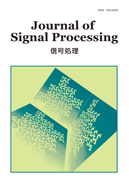All issues

Volume 16, Issue 1
Displaying 1-4 of 4 articles from this issue
- |<
- <
- 1
- >
- >|
-
Takahiro Sasaki, Kentaro Kinoshita, Satoru Kishida, Yoshiharu Hirata, ...2012 Volume 16 Issue 1 Pages 45-55
Published: January 31, 2012
Released on J-STAGE: March 15, 2013
JOURNAL FREE ACCESSWe construct systems including neural networks for detection of abnormal shadows in X-ray images of lungs and investigate the relationship between performance of the systems and pre-processing of input patterns. We use 32 images included 16 types of diseases and picked up 128 one-dimensional numeric sequences from the images. Then, the sequences are pre-processed for input patterns into the neural networks by averaging the values of data in the sequences and using differential filters. From the results, we found that the performance of the systems was affected by the pre-processing of the input patterns. The best values of equal error rate and AUC in our paper were 7% and 0.95, respectively, where the pixel values of the images were used as input patterns. The results obtained by using the one-dimensional numeric sequences from the images were comparable with the results of previous systems using two-dimensional information. Thus, our systems are thought to be useful for computer aided diagnosis with X-ray images of lungs.View full abstractDownload PDF (2052K) -
Atanu Saha, Tetsuya Shimamura2012 Volume 16 Issue 1 Pages 57-65
Published: January 31, 2012
Released on J-STAGE: March 15, 2013
JOURNAL FREE ACCESSIn this paper, we propose an approach to estimate the speech presence probability for speech enhancement. The approach is based on computing a self-adaptive estimator for the a priori speech absence probability using the SNR (signal-to-noise ratio) discrepancy. The performance evaluation is carried out in terms of objective and subjective evaluations. The evaluation results show that the proposed approach provides a significant improvement when incorporated into a speech enhancement system.View full abstractDownload PDF (1891K) -
Jia Su, Takeshi Ikenaga2012 Volume 16 Issue 1 Pages 67-78
Published: January 31, 2012
Released on J-STAGE: March 15, 2013
JOURNAL FREE ACCESSH.264/AVC often leads to high computational complexity, which induces high power dissipation when a tremendous number of cameras is installed to build a large-scale surveillance system. Moreover, there is much background video compression redundancy in the surveillance scene. To solve this problem from both computer vision and video compression points of view, we propose a multi-objective optimized motion block detector for skip-mode predetermination in motion estimation H.264/AVC. The proposed algorithm contains two stages: multi-objective-optimization-based motion block detector and an application in the skip-mode decision of the fast motion estimation algorithm for video surveillance scenes. In the prestage, a motion detector with an enhanced difference filter and weighted erosion filter was designed, in which multi-objective optimization was introduced for automatically determining the weights for each filter. For the uninterested static macroblock, a low-bit-rate skip mode can be directly chosen as the best mode while performing motion estimation. Compared with the statistical and knowledge-based object detector (SAKBOT), the proposed motion detector can achieve a time saving of more than 40% on average, while attaining a high accuracy for most indoor and outdoor surveillance test sequences. Compared with the UMHexagonS fast block matching method of JM11.0, it can achieve a time saving of 23%-41% in motion estimation (ME) and higher detection accuracy for uncompressed surveillance videos.View full abstractDownload PDF (4476K) -
Suhaila Sari, Tetsuya Shimamura2012 Volume 16 Issue 1 Pages 79-85
Published: January 31, 2012
Released on J-STAGE: March 15, 2013
JOURNAL FREE ACCESSThis paper presents a Wiener-filter-based image denoising technique with improved performance that employs a new power spectrum estimation method. The frequency domain Wiener filter is implemented and compared with the Wiener filter in other domains, such as the spatial and wavelet domains. It is also compared with state-of-the-art filtering approaches. The proposed power spectrum estimation method thresholds the power spectrum of a noisy image into two regions: low- and high-frequency regions. The image power spectrum is obtained from the low-frequency region because image components are generally concentrated at low frequencies. The noise power spectrum is obtained from the high-frequency region because noise is assumed to be concentrated at high frequencies. To remove noise more accurately, the noise power spectrum is also estimated from the low-frequency region because white noise exists with a flat power spectrum distribution throughout the noisy image. Simulation experiments show that the frequency domain Wiener filter with the proposed power spectrum estimation method preserves an image's fine textures and edges effectively. The filter is found to be lower or equivalent in computational complexity when compared with the conventional approaches.View full abstractDownload PDF (1756K)
- |<
- <
- 1
- >
- >|